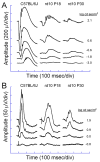Two mouse retinal degenerations caused by missense mutations in the beta-subunit of rod cGMP phosphodiesterase gene
- PMID: 17267005
- PMCID: PMC2562796
- DOI: 10.1016/j.visres.2006.11.020
Two mouse retinal degenerations caused by missense mutations in the beta-subunit of rod cGMP phosphodiesterase gene
Abstract
We report the chromosomal localization, mutant gene identification, ophthalmic appearance, histology, and functional analysis of two new hereditary mouse models of retinal degeneration not having the Pde6brd1("r", "rd", or "rodless") mutation. One strain harbors an autosomal recessive mutation that maps to mouse chromosome 5. Sequence analysis showed that the retinal degeneration is caused by a missense point mutation in exon 13 of the beta-subunit of the rod cGMP phosphodiesterase (beta-PDE) gene (Pde6b). The gene symbol for this strain was set as Pde6brd10, abbreviated rd10 hereafter. Mice homozygous for the rd10 mutation showed histological changes at postnatal day 16 (P16) of age and sclerotic retinal vessels at four weeks of age, consistent with retinal degeneration. Retinal sections were highly positive for TUNEL and activated caspase-3 immunoreactivity, specifically in the outer nuclear layer (ONL). ERGs were never normal, but rod and cone ERG a- and b-waves were easily measured at P18 and steadily declined over 90% by two months of age. Protein extracts from rd10 retinas were positive for beta-PDE immunoreactivity starting at about the same time as wild-type (P10), though signal averaged less than 40% of wild-type. Interestingly, rearing rd10 mice in total darkness delayed degeneration for at least a week, after which morphological and functional loss progressed irregularly. With the second strain, a complementation test with rd1 mice revealed that the retinal degeneration phenotype observed represents a possible new allele of Pde6b. Sequencing demonstrated a missense point mutation in exon 16 of the beta-subunit of rod phosphodiesterase gene, different from the point mutations in rd1 and rd10. The gene symbol for this strain was set as Pde6bnmf137, abbreviated nmf137 hereafter. Mice homozygous for this mutation showed retinal degeneration with a mottled retina and white retinal vessels at three weeks of age. The exon 13 missense mutation (rd10) is the first known occurrence of a second mutant allele spontaneously arising in the Pde6b gene in mice and may provide a model for studying the pathogenesis of autosomal recessive retinitis pigmentosa (arRP) in humans. It may also provide a better model for experimental pharmaceutical-based therapy for RP because of its later onset and milder retinal degeneration than rd1 and nmf137.
Figures











Similar articles
-
Different effects of valproic acid on photoreceptor loss in Rd1 and Rd10 retinal degeneration mice.Mol Vis. 2014 Nov 4;20:1527-44. eCollection 2014. Mol Vis. 2014. PMID: 25489226 Free PMC article.
-
Single-stranded oligonucleotide-mediated in vivo gene repair in the rd1 retina.Mol Vis. 2007 May 2;13:692-706. Mol Vis. 2007. PMID: 17563719 Free PMC article.
-
Retinal degeneration 12 (rd12): a new, spontaneously arising mouse model for human Leber congenital amaurosis (LCA).Mol Vis. 2005 Feb 28;11:152-62. Mol Vis. 2005. PMID: 15765048
-
Retinal degeneration mutants in the mouse.Vision Res. 2002 Feb;42(4):517-25. doi: 10.1016/s0042-6989(01)00146-8. Vision Res. 2002. PMID: 11853768 Review.
-
Focus on molecules: rod cGMP phosphodiesterase type 6.Exp Eye Res. 2007 Jan;84(1):1-2. doi: 10.1016/j.exer.2005.12.012. Epub 2006 Mar 23. Exp Eye Res. 2007. PMID: 16563379 Free PMC article. Review. No abstract available.
Cited by
-
Novel Insights into Beta 2 Adrenergic Receptor Function in the rd10 Model of Retinitis Pigmentosa.Cells. 2020 Sep 9;9(9):2060. doi: 10.3390/cells9092060. Cells. 2020. PMID: 32917020 Free PMC article.
-
Caspase inhibition with XIAP as an adjunct to AAV vector gene-replacement therapy: improving efficacy and prolonging the treatment window.PLoS One. 2012;7(5):e37197. doi: 10.1371/journal.pone.0037197. Epub 2012 May 16. PLoS One. 2012. PMID: 22615940 Free PMC article.
-
NRF2 promotes neuronal survival in neurodegeneration and acute nerve damage.J Clin Invest. 2015 Apr;125(4):1433-45. doi: 10.1172/JCI79735. Epub 2015 Mar 23. J Clin Invest. 2015. PMID: 25798616 Free PMC article.
-
Gradual Increase in Environmental Light Intensity Induces Oxidative Stress and Inflammation and Accelerates Retinal Neurodegeneration.Invest Ophthalmol Vis Sci. 2020 Aug 3;61(10):1. doi: 10.1167/iovs.61.10.1. Invest Ophthalmol Vis Sci. 2020. PMID: 32744596 Free PMC article.
-
Loss of Fas Receptor Function Preserves Photoreceptor Structure and Function in Two Mouse Models of Inherited Retinal Degeneration.Invest Ophthalmol Vis Sci. 2022 Sep 1;63(10):5. doi: 10.1167/iovs.63.10.5. Invest Ophthalmol Vis Sci. 2022. PMID: 36083588 Free PMC article.
References
-
- Beavo JA, Conti M, Heaslip RJ. Multiple cyclic nucleotide phosphodiesterases. Mol Pharmacol. 1994 Sep;46:399–405. - PubMed
-
- Chang B, Hawes NL, Hurd RE, Davisson MT, Nusinowitz S, Heckenlively JR. Retinal degeneration mutants in the mouse. Vision Res. 42:517–25. - PubMed
-
- Clapcote SJ, Lazar NL, Bechard AR, Wood GA, Roder JC. NIH Swiss and Black Swiss mice have retinal degeneration and performance deficits in cognitive tests. Comp Med. 2005 Aug;55:310–6. - PubMed
-
- Errijgers V, Van Dam D, Gantois I, Van Ginneken CJ, Grossman AW, D'Hooge R, De Deyn PP, Kooy RF. FVB.129P2-Pde6b(+) Tyr(c-ch)/Ant, a sighted variant of the FVB/N mouse strain suitable for behavioral analysis. Genes Brain Behav. 2006 Nov 3 [Epub ahead of print] - PubMed
Publication types
MeSH terms
Substances
Grants and funding
LinkOut - more resources
Full Text Sources
Other Literature Sources
Medical
Molecular Biology Databases
Research Materials
Miscellaneous

